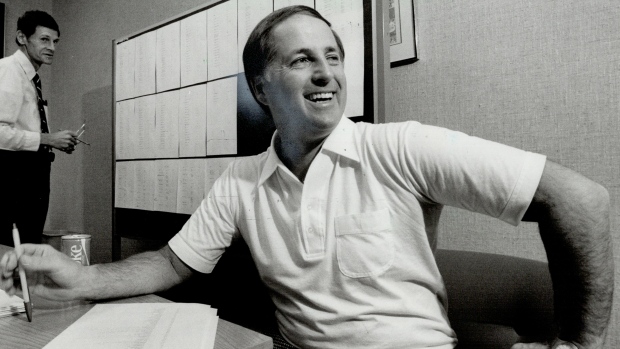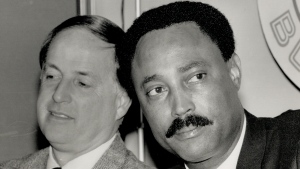Nov 8, 2016
The original architect of Blue Jays baseball
Today on SportsCentre marks the debut of the TSN Original feature 'Pay It Forward,' a story about the unique relationship between former Blue Jays GM Pat Gillick and Willie Aikens, Long-time Blue Jays writer Bob Elliott looks back at Gillick’s career with the Jays.
, TSN.ca Staff

Today on SportsCentre marks the debut of the TSN Original feature “Pay It Forward,” a story about the unique relationship between former Blue Jays general manager Pat Gillick and Willie Aikens, who played in Toronto for a little over a season in the mid-1980s. Long-time Blue Jays beat writer and columnist Bob Elliott looks back at Gillick’s career with the Jays, and explains why the Hall of Fame executive may be the most important employee in the team’s 40-year history.
On a cloudless Saturday afternoon in May of 1998, the burly reliever closed out the opposition with a fastball clocked at 92-94 miles per hour.
As players left the dugout at the dusty Hamilton sandlot in groups, a chosen few were stopped by evaluators, like steers cut from the herd by cowboys at round-up time.
After talking to one scout doing prep work for the June draft, said reliever, Denis Gratton, went to his Ontario Blue Jays coach Gary Wilson to complain: Who was the man wearing cowboy boots and why was he asking me so many questions?
“You don’t know who he is? Seriously?” Wilson repeated, his voice rising. “That’s Pat Gillick. He was general manager of the Toronto Blue Jays when they won back-to-back in 1992-93 and now he’s the GM of the Baltimore Orioles. Someday he’s going to Cooperstown.”
If a high schooler didn’t recognize the architect of the Blue Jays five years after the last World Series parade, what are the chances someone who discovered the game when Troy Tulowitzki arrived in August of 2015 knows the work Gillick did for the franchise?
* * *
Gillick’s name is up there on the Rogers Centre Level of Excellence, and a blue banner with his name on it signifies his 2011 induction to Cooperstown, but what else is there to know about this man?
He was hired from the New York Yankees in 1976 on the advice of Toronto Star baseball writer Neil MacCarl, according to original Jays GM Peter Bavasi. Management of the expansion club had been leaning towards hiring John Claiborne from the Boston Red Sox.
The son of a rock-throwing sheriff from Chico, Calif., Gillick was a left-handed pitcher who spent five seasons in the minors, reaching Triple-A Vancouver before injuries ended his career. And if he hadn’t been hurt? “I was a little short [on talent],” he has often answered.
He pitched the University of Southern California to the College World Series in 1958, and hitchhiked north to pitch for the Vulcan Elks and the Granum White Sox in Alberta summer ball. After retiring, Paul Richards hired him to work in scouting with the Houston Astros.
Gillick was acquiring players and trying to build a winner from Day 1 with the Jays ... and even the day before. The Seattle Mariners and Blue Jays took turns at the microphone during the expansion draft on Nov. 5, 1976. The day before, the Jays acquired Phil Roof from the Chicago White Sox.

Like all baseball architects, not every move worked for Gillick. He dealt fan favorite John Mayberry to the New York Yankees for Tom Dodd, Dave Revering and Jeff Reynolds in 1982. At the 1982 winter meetings in Hawaii, he dealt established closer Dale Murray to the Yankees for Dave Collins and two minor leaguers.
“Right now it’s known as the Dale Murray deal,” Gillick said at the time, “but some day we hope it is known as the Fred McGriff deal.” It was. Acquired from the Yankees at age 18, McGriff went on to hit 493 career homers.
When he acquired Willie Aikens from the Kansas City Royals on Dec. 20, 1983, for Jorge Orta, some fans wrote letters to newspapers complaining. Toronto signed Aikens to a two-year deal despite the fact he was facing a three-month sentence on a misdemeanour cocaine offense.
After voluntary therapy in a Baltimore hospital, Aikens made his Blue Jays debut May 16 at Minneapolis in a pinch-hitting role. He made 83 starts for the Jays in 1984 and 11 the next season, mostly as a DH. Demoted to Triple-A Syracuse on April 29, 1985, he never returned.
Gillick gave Aikens a second chance, and while not the player he was with K.C., it was the start of a beautiful, life-long friendship.
That 1985 season was the Jays first visit to October ball as they won the American League East with a franchise-record 99 wins.
* * *
Starting in 1983, Gillick’s Jays reeled off a then-record 11-consecutive winning seasons. Yet there was impatience among Blue Jays fans. The Jays were called the “Blow Jays” for falling short in the postseason. Gillick picked up the nickname Stand Pat.
Toronto Sun columnist Jim O’Leary noticed the Jays had not made a trade in 444 days, the same length of time U.S. hostages were held in the Iran hostage crisis. The Sun ran a chart. We ran it at 500 days, at 550, and every day during the winter meetings.
I was talking on the pay phone at Pearson Airport on the way to the 1988 winter meetings when I felt someone grab my boarding pass out of my pocket. Gillick at work.
After getting off the phone I caught up with him in line. A fan approached and asked, “Off to Nashville? Going to make any trades Mr. Gillick?”
Gillick said yes, they’d try and thanked him for being a fan.
The fan held up the Sun, open to the Stand Pat chart and shoved it towards his face saying: “Well, it’s about time.”
It was pretty funny and awfully awkward as I waited for Gillick to rip up my boarding pass.
Then, he reached the counter.
“Look this guy here he doesn’t get out much,” he said to the check-in agent. “He has never, ever, ever been in first class. He’s out of work. Could you bump him to first class?”
* * *
The tradeless streak ended at 629 days when Jesse Barfield was sent to the Yankees for Al Leiter. The Jays lost the 1989 American League Championship Series to Oakland.
The franchise changed, moving from bridesmaid status in December at the 1990 winter meetings at the Hyatt O’Hare. On a Sunday night at 10 p.m. Toronto time they obtained centre fielder Devon White from the California Angels for Junior Felix. Four days later, Tony Fernandez and McGriff were sent to the San Diego Padres for the Robbie Alomar and Joe Carter.
The Jays lost the 1991 ALCS to the Twins and then won back-to-back titles with Alomar and Carter playing leading roles. Gillick added David Cone after the trade deadline in 1992 for Jeff Kent, and the next year acquired Hall of Famer Rickey Henderson.
* * *
The strike-shortened 1994 season was his last as Blue Jays GM. The next year he was a special assistant to Gord Ash and then he was gone from the Toronto scene.
Gillick sat out the 1996 season, ran the Baltimore Orioles for three seasons, sat out a year, then ran the Seattle Mariners four years before heading to the Philadelphia Phillies. He guided the Phillies to the 2008 World Series, the city’s first baseball title since 1980 and second in 125 years.
His Blue Jays, Orioles, Mariners and Phillies reached postseason play 11 times in a 20-season stretch, finishing second in the division four times. He was a GM for 27 seasons in all.
The Jays went 21 seasons after he left before reaching October in 2015. The Orioles went through a 15-year drought until they qualified in 2012. The Mariners are at 13 straight and counting. The Phillies were back in postseason in 2009 after Gillick stepped down, the first of three straight postseason appearances before missing the last five.
* * *
There are 1,001 Gillick stories that illustrate his character. The best is the turtle story, which Mike Berardino wrote in Baseball America in 1994.
Gillick came upon a turtle holding up traffic as it tried to cross a two-lane road in central Florida. Gillick pulled over his rental car, walked past several motorists, scooped up the turtle, then got the traffic flowing again like a traffic cop, turning one way, then the other. He carried the turtle to the safety of the shoulder and returned to the car.
Sliding behind the wheel with a big smile for all that was right with the world, he was about to turn the key when his wife Doris said, “Patrick, you have to re-do it.”
“The turtle was trying to get to the other side. You brought him back where he came from.”
Traffic was moving again, yet Gillick got out, waited for a break, picked up the turtle and took him to his destination. And that’s the story of how the turtle crossed the road.
* * *
Gillick was elected to Cooperstown by a 16-member committee examining veterans on an Expansion Era ballot. He joined Ed Barrow and George Weiss of the Yankees and Branch Rickey of the Brooklyn Dodgers as the only other GMs elected to the Hall of Fame.

“I told Pat ‘Now the other three will have a foursome for Bridge,’” said Jeff Idelson, the Hall’s president on Election Day at Lake Buena Vista, Fla.
Now a senior advisor to the Phillies president and GM Andy MacPhail, Gillick lives in Birmingham, Mich., so that he and wife Doris can be close to grandson Cooper, daughter Kim and her husband David, who lives and dies with the Blue Jays.
And what ever happened to Denis Gratton the hard-throwing high schooler?
Gillick’s Orioles drafted him in the 18th round, but he injured his elbow his first spring and never pitched in a pro game.
Baseball’s greatest architect didn’t bat 1.000, but his batting average is better than anyone.
Bob Elliott is a past recipient of the Canadian Baseball Hall of Fame’s Jack Graney Award. He started his career in 1978 as a reporter covering the Montreal Expos, before moving to Toronto, where he covered the Blue Jays for 30 seasons until his retirement earlier this year. Elliott spends his time on his Canadian Baseball Network site.

